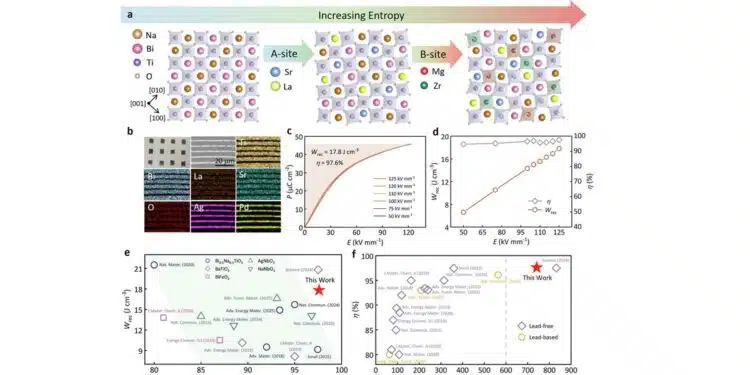This post presents the findings from the research article titled “Enhanced energy-storage in lead-free multilayer capacitors via entropy-assisted polymorphic domain engineering” published in Nature Communications (2025).
The study focuses on improving the energy storage performance of environmentally friendly, lead-free multilayer ceramic capacitors (MLCCs) through a stepwise dual-site entropy-assisted engineering strategy.
The use of high-entropy design facilitates the coexistence of multiple polymorphic domains and enhances the dielectric breakdown strength, leading to superior energy storage density and efficiency.
Key Points
- Development of lead-free Bi0.5Na0.5TiO3 (BNT)-based MLCCs using a dual-site, stepwise entropy-increase strategy.
- Coexistence of rhombohedral (R), tetragonal (T), and cubic (C) domains delays polarization saturation while maintaining high maximum polarization (Pm).
- Entropy-induced non-periodic lattice distortion leads to grain refinement and substantially improved electrical resistance.
- Achieved a recoverable energy density (Wrec) of 17.8 J·cm−3 with an energy efficiency (η) of 97.6%.
- MLCCs demonstrated excellent thermal, fatigue, and frequency stability, suitable for pulsed power applications.
Extended Summary
1. Entropy-Assisted Design of MLCCs
The research introduces a two-step dual-site entropy-increase approach to optimize the structure of BNT-based MLCCs. First, Sr2+ and La3+ were incorporated at the A-site to form a medium configuration entropy (Sconfig) component. Subsequently, Mg2+ and Zr4+ were introduced at the B-site, resulting in high Sconfig (1.60 R). This dual-site approach promotes structural disorder, facilitating the formation of multiple coexisting nanodomains, including R3c, P4bm, and cubic phases.
2. Energy Storage Performance
The energy storage performance of the MLCCs was assessed via unipolar polarization–electric field (P-E) loops. The recoverable energy density and efficiency are given by:
Wrec = ∫ E dP , η = (Wrec / Wtotal) × 100%
The high-entropy BNSLTMZ MLCCs achieved:
| Sample | Wrec (J·cm−3) | η (%) | Eb (kV·mm−1) |
|---|---|---|---|
| BNT (pristine) | 2.1 | 10 | 40 |
| BNSLT (medium entropy) | 5.2 | 85.4 | 60 |
| BNSLTMZ (high entropy) | 17.8 | 97.6 | 125 |
Notably, the MLCCs maintained low remanent polarization (Pr) and demonstrated slender P-E loops, indicative of efficient relaxor behavior.
3. Structural and Microstructural Insights
High-resolution X-ray diffraction (XRD), Raman spectroscopy, and aberration-corrected HAADF-STEM revealed the coexistence of multiple polymorphic domains and transition regions. The cation displacement mapping and lattice distortion analysis showed that entropy-induced non-periodic distortions delay polarization saturation and enhance breakdown endurance.
The average grain size decreased from 2.01 μm in pristine BNT to 0.67 μm in the high-entropy sample, which correlates with increased electrical resistance and suppressed leakage currents (from 8.3×10−8 to 8.1×10−9 A·cm−2).
4. Stability and Charge-Discharge Characteristics
The MLCCs exhibited superior stability across a broad range of temperatures (0–100 °C), frequencies (10–100 Hz), and fatigue cycles (up to 106). Charge-discharge tests demonstrated a high discharge energy density (Wd > 5.6 J·cm−3) and rapid discharge time (t0.9 ≈ 0.83 μs) under an electric field of 70 kV·mm−1. The peak current density achieved was 311 A·cm−2, with a power density of 108 MW·cm−3.
Conclusion
The stepwise dual-site entropy-assisted strategy successfully enhances the energy storage properties of lead-free BNT-based MLCCs. By inducing polymorphic domain coexistence and lattice distortions, the approach improves maximum polarization, breakdown strength, and energy efficiency. The resulting MLCCs combine high recoverable energy density, exceptional efficiency, and robust operational stability, positioning them as promising candidates for next-generation pulsed power and energy storage applications.
Read the complete article:
Li, J., Zhang, Y., Liu, Z. et al. Enhanced energy-storage in lead-free multilayer capacitors via entropy-assisted polymorphic domain engineering. Nat Commun 16, 8580 (2025). https://doi.org/10.1038/s41467-025-63584-y






























